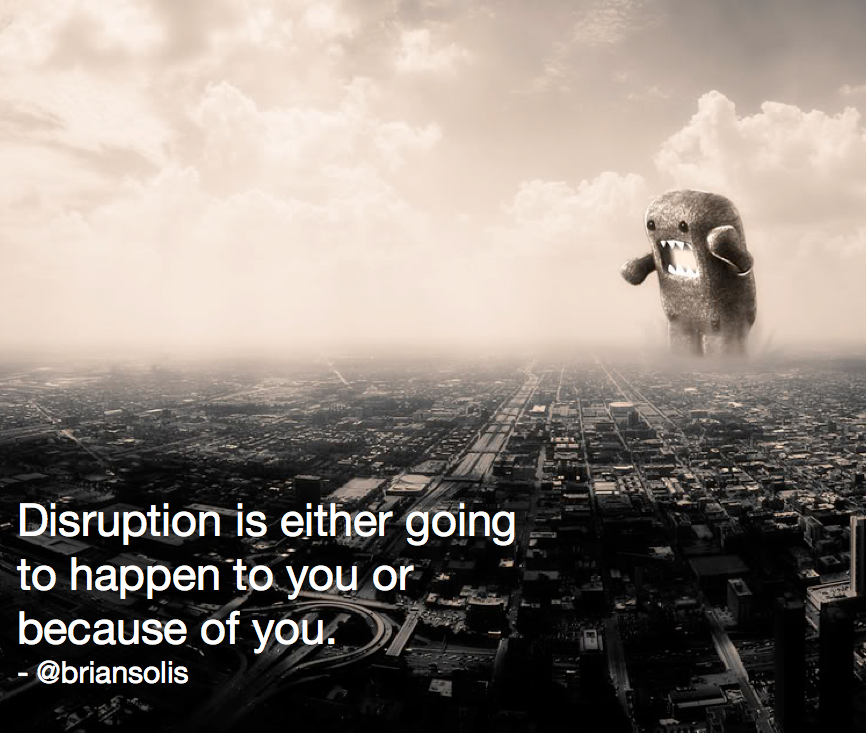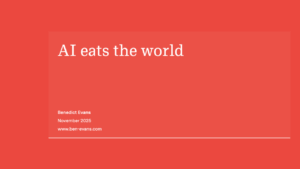Each year at this time, I read all of the predictions for the new year plus the “top X” lists wrapping out the previous year. Add to that the first week of chaos that is CES and all of the new tech debuting in Las Vegas. And each year, I’m left wanting more substance as I plan my research. So, in 2015, I officially threw my hat into the mix with my inaugural look at “25 Disruptive Technology Trends in 2015 – 2016.”
Rather than look at just one year ahead, I organized my research against a two-year horizon and then added an analytical layer of what each trend meant and why each was important. But that still wasn’t enough. Nothing moves in calendar cycles except for taxes, birthdays, anniversaries, earning reports, etc. So, this year, I added one year to the event horizon…
Introducing the “26 Disruptive Technology Trends for 2016 – 2018.”
In this report, we’ll explore some of the disruptive trends that are affecting pretty much everything over the next few years-at least those that I’m following. It’s not just tech, though. The report is organized by socioeconomic and technological impact.
Obviously, this is not an exhaustive list of every technology and societal trend bringing about disruption on planet Earth. What follows thought definitely affects the evolution of digital Darwinism, the evolution of society and technology and its impact on behavior, expectations and customs.
Disruptive Trends: Socioeconomic trends that are notably impacting civilization in the near-term.
1) The New Brand: Experiences are More Important Than Products
Customer experiences become more important than products; companies now have to consider how products and services enhance specific lifestyles and workflows.
The legacy value of brands is overtaken by brands that earn relevance by investing in engagement and collaboration in moments of truth…beyond creative. Marketing becomes CX. This includes the sum of all disparate parts, marketing, product, sales, service, support, CRM, R&D, etc. Brands must also zero-in on the needs, values and aspirations of a generation that defines everything radically differently than previous generations.
2) Goodbye Sharing Economy, I Want My On-Demand Economy…Now!
Was there ever really a sharing economy if no one was actually sharing? The sharing economy officially dissolves: everything becomes on-demand and this forces economists and ultimately businesses to understand new markets and workforces that create alternative supply based on rising demand. On-demand companies and their ecosystems of workers and customers trade on the value of reputation + trust + value.
Beyond seeing the “Uber or Airbnb of everything,” new classes of services will rise and fall based on new behavior and expectations. I also refer to this movement as the “selfish” economy in that consumers will expect every business, even those that are traditional, to do business where transparency, immediacy and context reign supreme. Everything will be on-demand, including B2B services.
3) Digital Detox Improves Digital Productivity
Digital is its own drug. People will learn how to hack their workflow because they have to. There’s too much email, too many meetings and not enough leadership to change routines. This leads to the need for individual productivity hacks. These acts go beyond employee efficiency; they will improve experiences and relationships professionally and personally. Everyone will need some sort of digital detox and/or focus.
While some will simply unplug from the Internet, others will discover and share “life hacks” such as…
- Writing down distractions from tasks at hand
- Checking email once a week
- Scheduling meetings in 20-25 minute increments
- Listening to music without lyrics
- Spending 10 minutes a day on Headspace
- Fasting from media
- Not responding to every txt
- Turning off all desktop, social and mobile notifications
4) Every Company Undergoes Digital Transformation and Gains Empathy in the Process
Digital transformation – the re-alignment of, or new investment in, technology and business models to more effectively compete in a digital economy – becomes standard. Companies will invest in digital customer experiences to improve experiences for all customers and employees.
There is no one type of customer or employee. Thus, digital transformation efforts will not be informed by digital trends; instead, social science will help decision-makers better understand how digital trends affect how people work, shop, communicate, what they value etc. Technology will then be an enabler to human-centered transformation in the enterprise to create more adaptive models, processes and systems to evolve.
5) The Dynamic Customer Journey Changes Brand Dynamics
The customer journey decentralizes, becoming a series of non-linear mobile-centric micro-moments, mimicking everyday consumer activity and communication. This sets the stage for relevant brand and product serendipity.
For example, Google learned that 90% of smartphone users are not absolutely certain of the specific brand they want to buy when they begin looking for information online. And, 65% look for the most relevant information regardless of the company providing it. How companies become discoverable and how they lead customers through their journey requires a new marketing infrastructure to support a customer journey comprised of micro-moments. This means that legacy strategies are good only for yesterday’s customers. To reach mobile customers in each moment of truth requires new methodologies for search, advertising, content engagement, sales and support.
6) The Consumerization of Work Turn Employees into Collaborators
The consumerization of work goes beyond IT and devices; workflow, behavior and expectations mimic real-world apps like Snapchat, Uber, Tinder, etc.
Digital employees and customers think, act and expect differently. They want every business to feel, serve and work just like their favorite apps.
Enterprise software will start to mimic consumer apps and ultimately reshape the role of IT and the processes it manages to support employees. Slack is just the beginning of an enterprise renaissance that doesn’t just change tech – it changes how companies (and people) work.
7) Humans Need Not Apply for Old Jobs
The gap between expertise for the jobs of yesterday and tomorrow is widening. Everyone becomes students again. Yes – robots already are and will continue to automate workflow. Factories aside, intelligent devices are replacing people in front-line roles such as those at eateries, including Eatsa and McDonalds.
Traditional education no longer suffices as people are learning basic skillsets without understanding or knowing how they correlate to tomorrow’s careers. People will specialize in tasks that computers need humans to complete. Scholastic and workplace education will formalize computer-proof and computer-partnered careers and programs, and thus education becomes a constant.
8) The Age of Corporate Renaissance
Old ways give to new business models, processes and philosophies; disparate departments merge, uniting tech and complementary disciplines.
Marketing and IT work together rather than compete. CX, CRM and marketing form new experience teams.
CIOs realize the “I” stands for “innovation” and as such understand external/internal behavior to rethink how people and tech work together now and in the future.
Training and education become proactive to help modernize the workforce.
HR undergoes a renaissance to provide a workplace that is native to Millennials and up-and-coming Centennials.
9) Corporate Innovation Centers Displace or Complement R&D; The Maker Movement Becomes Threat or BFF to Incumbent Companies
Traditional R&D is no longer sufficient. Big companies invest in innovation centers: some aim to act like startups, others set out to partner with or acquire them, and some seek to lure people away from #startuplife.
Either way, innovation centers allow slow-moving, risk-averse companies to spark new ideas, experiment faster, fail faster and gain momentum to affect HQ and force change from the outside-in.
Some great innovation that cannot see the light of day within larger organizations will develop new markets, upset incumbents and either succeed solo or rollup into those companies that could not innovate.
The maker movement is “Shark Tank” for geeks and it doesn’t need judges to fund them; there’s Indiegogo, Gofundme, Kickstarter, et al. for that.
10) Culture Finally Gets Its Time in the Spotlight – Welcome to Culture 2.0
Culture is largely misunderstood and undervalued by the C-Suite today. It’s one of the reasons morale is at an all-time low. This will change because it has to. Employee engagement or the lack thereof creates a morale-busting “engagement gap”, giving way to an executive-level charter to invest in “culture 2.0”
11) Businesses Must Live by Radical Transparency to Gain Trust and Business of Customers
Businesses must also practice radical transparency or risk irrelevance. Customers want to do business with companies that match their beliefs and values. Customers are more aware and informed now. This means businesses must run counter to its normal practices, change and communicate this vision and changes in everything. With a more plugged-in understanding of human nature, businesses will not only create a happier and more productive culture: they will benefit from empowered employees, leading to an internal renaissance that yields new and innovative products, services, processes, and more.
12) Schools Pay Students to Learn and Become Agencies that Connect Companies with Expertise
The race for technical talent extends to Africa and other non-traditional establishments (such as prisons, etc.) to train qualified students computer and engineering sciences. Specialized schools will identify and teach students – even pay them to learn – and become an IP lab for companies to employ, similar to how outsourcing of other business functions works today.
Technology Trends: Technology trends that are changing how people live (and for how long), communicate, network and work.
13) Jarvis is Your New Chat Buddy and He Ushers in a Dawn of Conversational Commerce
Chatbots (and a dash of human interaction) turn messaging into concierge services (aka virtual assistants) and eventually predictive services that simplify everything from search to shopping to travel to customer service.
This sets the foundation for “conversational commerce.” The ability to buy products and order services without leaving the chat window becomes the new norm for everyday shopping, much like Amazon has become the standard for e-commerce.
Intelligent attendants such as Microsoft Cortana, Google Now, Amazon Alexa and Apple Siri will become staples in how people navigate life and work. Very soon, the complicated and often silly questions you ask of Alexa and Siri, will be answered.
You’ll be taken aback for a split second and then you’ll go on as if you couldn’t have lived without it.
14) Mobile-first Behavior Transforms the Web
The entire Web will be re-imagined for a mobile-first and mobile-only world that is screen, location, context and intention-aware. This radically transforms the purpose of the web to become more dynamic, personal and useful at a time when people are forcing the end of a traditional information-broadcast, page/form-based, keyword world. Everything from websites to apps to commerce will require overhaul or complete innovation to cater to the EGOsystem, or the demand for real-time personalized engagement.
15) The New @Machine Age Discovers the Fountain of Sleuth
Quantum computing dramatically accelerates the artificial intelligence race, applying machine calculations that are 100 million times as fast as today’s machines. IBM’s Watson is being applied to healthcare, finance and even cooking, to explore new solutions in cognitive computing. AI can sort through and assess information that humans may have missed or never considered. This type of work is already leading to new treatments, products, services, and yes, recipes. You can bet it will also be applied to call center technology and may or may not make you want to use counter services such as @service in response.
Artificial intelligence is just one area that will benefit from experimentation. Machine learning will also yield innovation in pattern recognition, predictive analysis, mimicked common sense, and even new ways to compute and solve problems.
More immediately though, breakthroughs in programming will eventually iterate and innovate existing engineering issues, air traffic control, curing diseases, etc.
16) Reactive Medicine Gets Proactive
Regenerative medicine cuts through the ethics debate by helping everyone gain access to cloneable organs.
Nanobots will be able to assess and fix us from within. Those made from our own DNA will eventually help cure us from deadly diseases ranging from blocked arteries to cancer.
Healthcare and athletic brands will also learn from Disney’s massive Magicband investment to bring big data insights to improve health and life experiences as part of a Human Operating System (Human OS). A human operating system becomes a platform for innovation that mimics the Apple product and iCloud universe. A Magicband-like device and other products designed to work in its ecosystem are constantly plugged into personal clouds accessible by healthcare providers. Blood, oxygen, vitals and more will shift the practice of medicine from reactive to proactive care.
17) The Sh#tshow that is The Internet of Things Finally Plugs into the Human OS
The Internet of Things becomes the Internet of Sh#t because it’s a mess with too many products and apps competing for consumer attention. This creates confusion and chaos as devices are proprietary, capabilities are too narrow and not reflective of everyday life and only a few companies such as Google’s Nest and Apple’s Homekit are designing plug-and-play smart ecosystems. Even still, technology must be invisible and interoperable.
Developers must plug into the Human Algorithm and the Human OS, envisioning the body and critical activities as an ecosystem/platform rather than technology and device-first products.
On the immediate horizon, smart connected products (The Internet of Things) will help consumers in transparent means, such as in-product communication, where products communicate to manufacturers, users and suppliers about state, maintenance needs and updates. This will be done in-home and also onsite where locations become smart about visitors to better guide experiences.
18) Live! Streaming! Mobile! Video! Now!
Live streaming (video) continues to bring niche moments to life, interrupting streams everywhere, making conversations on demand a form of engagement and entertainment. This makes everyday activities such as gaming, sports, concerts, events, TV, discussions, etc., become content and its hosts and participants the new weblebrities. This puts pressure on Youtube, Vine, Facebook, Snapchat to rethink video algorithms and subsequently monetization/advertising platforms. With streaming services forcing the unbundling of traditional subscription channels and the democratization of content production and distribution, consumers re-define programmatic content and reshape the definition of “TV.”
19) Say Hello To My Little Mends; Drones Join the Workforce
Drones will continue to revolutionize photography and videography but real innovation will derive from utility in vertical applications such as delivery, care, exploration, etc.
20) Ctrl-P: Print Solutions at Will
The proliferation of 3D printing solves problems and creates solutions in vertical industries (healthcare, aerospace, automotive, manufacturing, etc.), disrupting supply chains as it matures.
Personal applications will initially be served by brick and mortar establishments such as home improvement, auto repair, and other services where parts take time, are too expensive or unobtainable.
21) Siri, Take The Wheel
You may already own your last car. Autonomous vehicles will start to make their way onto public roads as laws rapidly iterate to make way for the inevitable. v1.0 will be very beta, with initial cars shipping with steering wheels and requiring drivers to “take a back seat” but be ready to take over at a moment’s notice. Fully autonomous, self-driving cars will be on the road by 2025. Cars will learn not only how to drive, but also how to limit or strategically consider accidents, injuries and even death of passengers, drivers and pedestrians.
Intelligent transportation not only changes how people, goods, etc., get from point A to point B, but also how vehicles and technology talk to one another to create safer passage ways. Each will also transform regulation to expedite a connected grid where transportation engineering and infrastructures as well as vehicles, gear, components, etc. work together.
22) Experiences Get Real Virtual
Oculus, Hololens, MagicLeap are bringing the virtual world to life. Immersive computing will find its niche beyond industrial design and start to permeate high-end gaming and other experiential sectors. It will open up an entirely new world that truly brings VR/AR alive…or closer to lifelike.
VR/AR are already a given. As gear becomes increasingly portable (think something like Google Glass), though, experience architects and next-gen imaging equipment will design immersive 360-degree experiences that don’t just replicate everyday life, but instead enhance and even challenge it. Think about shopping with products and attendants that appear out of nowhere, or information about products that come to life as you pick them up. When you visit Hawaii and the land where Jurassic Park was filmed, you will have the opportunity to actually visit Jurassic Park. Playing games where the field of play is your physical environment with challenges greeting you in your own space. Total Recall and Minority Report are just around the corner.
23) Power On…ward
In-home battery systems provide an entry-level solar solution to those with electric cars. Systems such as Tesla’s Powerwall and Powerpack lead to a battery innovation race that benefits households, devices/appliances and other goods powered by less eco-friendly means and the greater power sector.
24) Fashion Sense Gets Smart, Darlings
Intelligent or smart fabrics (E-textiles) make clothes more than fashionable or useful: they become part of a new genre in the wearable movement. Working together, many types of sensors integrated into one larger garment can tell different stories and unlock new possibilities.
Clothes will have beacon-like technology to control/inform surroundings. Clothing articles will transform based on environment and activities, and also sustain desired body temperatures.
Through Bluetooth technology, clothing will communicate body status to core devices that track performance, state, etc. for you and your healthcare provider.
25) Finance Gets a Makeover Inside and Out
The blockchain allows you to create a public ledger system that’s accessible for all, and secure. Blockchain technology will influence global financial organizations to rethink banking infrastructures. Rather than transacting based on the individual, currency and ultimately goods become individual assets. Each transaction becomes a micro-purchase around your account, but it doesn’t actually involve your personal authentication. Authentication is performed by your assets. All of this is recorded on your bank’s open blockchain ledger in real-time, easily and inexpensively.
Speaking of banks…based on the rise of the “selfish economy” and the consumerization of all tech, the idea of what a bank is and how people interact with it creates new micro-banks that look, act and perform banking functions for a digital/mobile generation.
26) The Cloud Takes Over Business
Critical ERP systems beyond CRM, marketing, etc. move to the cloud. Businesses cannot compete at the speed of digital Darwinism if they don’t change how they “do” business.
Nearly a third of all enterprise resource planning (ERP) systems in the world will attempt the migration to the cloud in the next two years.






That is rather a lot to achieve in 3 years. I’m reminded of William Gibson’s words – “The Future is here – it just isn’t evenly distributed”.
In revenue generation we are still in the long dark tea-time of the soul. The travelling salesman with his bag of samples, fast patter and hard sell techniques is long gone, but his shadow still hangs over us. The knee-jerk response of every corporate CEO when the sales figures are too low is to say “get out there and sell” – not look at product-market fit, demand generation or customer experience.
And the rest of the organisation is locked in the “Someone else’s Problem idea. They are in denial that their systems are part of the problem, making it harder to buy, distancing from, rather than empathising with the customer and making customers fit their channels and systems, rather than designing methods to suit buyer, influencer and intermediary.
But people and organisations don’t change at the speed of the market – their slow pace makes them uncompetitive, opening up a gap for a company which has already changed. Often this is a generational thing and the whole pre-internet generation needs to be pensioned off before real change happens. Prising people’s dead hands of the levers of power also takes time and the collapse through automation of the administrative class (mistakenly called the middle class by many), will leave a power vacuum.
Confucius’ curse – “May you live in interesting times” will haunt the next decade.
Thanks for the truly precise presentation, and it all sounds very good, and makes sense, but I feel you are forgetting one Super-Disruptive Techinnovation, that you allude to in your #25, but you don’t specifically make it the main emphatic point, which is…..the explosion of Crypto-Currencies since 2009 that is completely disrupting and in fact revolutionizing and radically improving the entire financial world, and it is all about breaking free from the strangling death grip of total control by the Big Banking Brotherhood, so that “We the Real Living & Working People” can actually have a pure powerful private and secure digital Online payment solution under our total control, and a few of the top Crypto-Currencies also offer a system to profit from using and sharing them,…..I’m involved with the best one out there, and it is positively awesome, and this is not a predictive “trend” waiting to truly happen between 2016 and 2018….it is exploding with success in over 190 countries right now, and by the end of this year will be the Hottest Buzz anywhere Online.
Love this comment Tari. Indeed. I believe crypto currencies made the last list. But please do share so I can stay up to speed on what you’re working on!
Many thanks really helpful. Will certainly share website with my friends.|
Brilliant article! Thank you very much. It’s an exciting yet scary reality and these trends are changing our every day world.